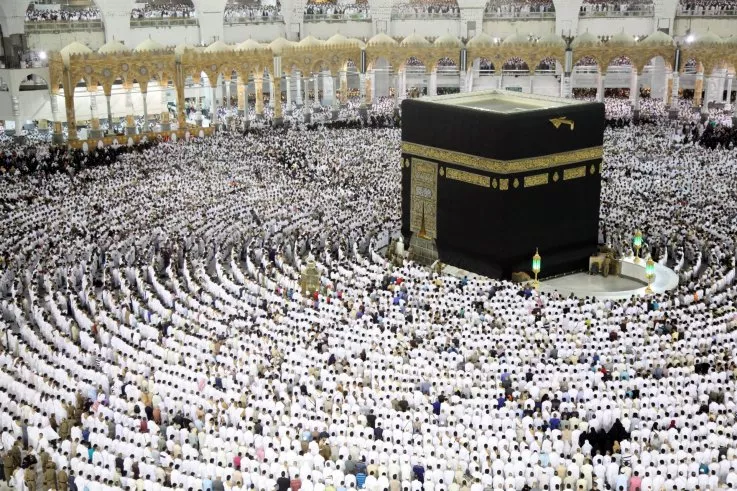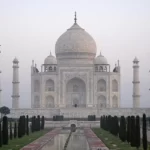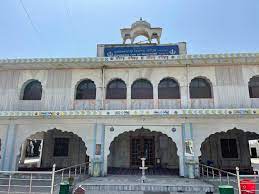The Kaaba, located in the heart of the Masjid al-Haram in Mecca, Saudi Arabia, is one of the holiest sites in Islam. Millions of Muslims around the world face towards the Kaaba during their daily prayers. While many people are familiar with the religious significance of the Kaaba, there are some lesser-known and intriguing facts that add depth to its history and cultural importance. In this blog post, we will explore 10 lesser-known facts about the Kaaba that might surprise you.
Architectural Marvel:
The Kaaba is not only a religious symbol but also an architectural marvel. It stands at a height of about 39 feet and is made of granite from the hills near Mecca. The interior walls are clad in marble and granite, while the exterior is covered with a black silk and gold curtain known as the kiswah.
The Kaaba, in addition to its profound religious significance, stands as an architectural marvel that has fascinated historians, architects, and visitors alike. The meticulous design and construction of the Kaaba contribute to its iconic presence and enduring appeal. Here are further insights into the architectural aspects that make the Kaaba a remarkable structure:
1. Unique Design:
The Kaaba features a simple cubic structure, a testament to the timeless principles of Islamic architecture. Its four corners align with the cardinal points of the compass, emphasizing symmetry and balance. The simplicity of its design underscores the Islamic belief in the oneness of God.
2. Materials and Construction:
The Kaaba’s construction materials are a blend of history and geography. The exterior is constructed from granite, sourced from the nearby hills of Mecca, while the interior walls are adorned with intricately patterned marble and other stones. The juxtaposition of these materials adds to the visual appeal and durability of the structure.
3. Golden Door:
The lone entrance of the Kaaba is adorned with a gold and silver door. This door, known as the Babut Taubah (Door of Repentance), is approximately 2 meters high and exhibits exquisite craftsmanship. Its golden embellishments serve as a striking contrast against the austere exterior, symbolizing the spiritual journey of those who enter.
4. Kiswah:
The exterior of the Kaaba is draped with a black silk and gold curtain known as the kiswah. This ornate covering is changed annually during the Hajj pilgrimage and is intricately woven with verses from the Quran in gold thread. The kiswah is a symbol of honor and reverence, reflecting the deep spiritual connection between the Kaaba and the Muslim community.
5. Dimensions and Proportions:
The Kaaba’s dimensions hold significant mathematical and geometric significance. It stands at a height of about 39 feet, with each side measuring approximately 40 feet. The proportions of the structure contribute to a harmonious and visually pleasing aesthetic.
6. Foundation Stone:
Beneath the Kaaba lies the Maqam Ibrahim, a sacred stone that is believed to bear the footprints of the Prophet Ibrahim. This stone is an integral part of the Kaaba’s foundation and adds a layer of historical significance to the structure.
7. Continuous Evolution:
The Kaaba has undergone several renovations and reconstructions throughout history. While maintaining its fundamental cubic form, these renovations have ensured the structural integrity of the Kaaba. The ability of the Kaaba to withstand the test of time is a testament to the skill of the architects and builders involved in its upkeep.
8. Holistic Symbolism:
Every aspect of the Kaaba’s design and adornment carries symbolic meaning. From the simplicity of the structure representing humility before God to the use of noble materials reflecting the sacredness of the site, the Kaaba’s architecture is infused with profound symbolism.
The Kaaba’s architectural brilliance extends beyond its religious significance, captivating the imagination of those who marvel at its design and construction. As a timeless symbol of faith and unity, the Kaaba’s architectural splendor continues to inspire awe and reverence among people from all walks of life.
Pre-Islamic Origins:
The Kaaba predates Islam and has a rich history. It is believed to have been built by the Prophet Ibrahim (Abraham) and his son Isma’il (Ishmael) as a house of worship for one God. The Kaaba has undergone several reconstructions over the centuries.
The pre-Islamic origins of the Kaaba add a layer of historical depth to its significance, emphasizing its role as a sacred structure with roots stretching back centuries. Understanding the origins of the Kaaba provides insights into its journey from a polytheistic shrine to the focal point of Islamic worship:
1. Construction by Prophet Ibrahim and Isma’il:
According to Islamic tradition, the Kaaba was initially constructed by the Prophet Ibrahim (Abraham) and his son Isma’il (Ishmael) under the command of God. The Quran mentions their role in building the Kaaba as a place of monotheistic worship, free from idolatry.
2. Hajar al-Aswad (Black Stone):
The Black Stone (Hajar al-Aswad) set in the eastern corner of the Kaaba is believed to have been given to Prophet Ibrahim by the archangel Gabriel. Some historical accounts suggest that the stone predates the construction of the Kaaba and was incorporated into the structure during its initial construction.
3. Pre-Islamic Pilgrimages:
Before the advent of Islam, the Kaaba was a center of pilgrimage for various Arabian tribes. Each year, during the months of pilgrimage, known as Hajj, these tribes would converge on Mecca to circumambulate the Kaaba, a practice that echoes the rituals performed by Muslims during the Hajj today.
4. Polytheistic Practices:
In pre-Islamic times, the Kaaba housed numerous idols representing different Arabian deities. These idols were objects of worship for various tribes, turning the Kaaba into a center for polytheistic practices. The annual pilgrimage, however, retained its significance even in this polytheistic context.
5. Abraha’s Invasion:
In the early 6th century, an event known as the Year of the Elephant occurred, during which Abraha, the Christian ruler of Yemen, attempted to destroy the Kaaba. However, according to Islamic tradition, his army was thwarted by a flock of birds that pelted them with stones.
6. Rededicating the Kaaba to Monotheism:
The Prophet Muhammad, before the advent of Islam, participated in the rebuilding of the Kaaba after a flood damaged its structure. It was during this reconstruction that the Kaaba was rededicated to the worship of the one true God, signaling a return to the monotheistic origins established by Prophet Ibrahim.
7. Inclusion in Islamic Worship:
When the Prophet Muhammad received revelations and Islam emerged as a monotheistic faith, the Kaaba, with its historical significance, became the focal point of Islamic worship. The rites of Hajj and Umrah, central pillars of Islam, are directly tied to the pre-Islamic pilgrimage practices centered around the Kaaba.
8. Symbolic Cleansing of Idolatry:
Upon the conquest of Mecca by the Muslims, the Prophet Muhammad cleansed the Kaaba of its idols, restoring it to its original purpose as a house of worship for one God. This symbolic act marked the culmination of the Kaaba’s journey from a polytheistic shrine to an emblem of monotheism.
In essence, the pre-Islamic origins of the Kaaba highlight its transformative journey from a polytheistic sanctuary to the spiritual epicenter of Islam. Understanding this historical context deepens the appreciation for the Kaaba’s role in shaping the religious landscape of the Arabian Peninsula and its enduring significance in the Islamic faith.
Changing Colors
The kiswah, the black cloth covering the Kaaba, is changed annually during the Hajj pilgrimage. It is traditionally made of black silk, but the color has varied throughout history. In the past, green, white, and red kiswahs were used.
The tradition of changing the color of the kiswah, the covering of the Kaaba, is a fascinating aspect of the Kaaba’s history and adds a layer of cultural and aesthetic richness to its significance. Here are more details on the changing colors of the kiswah:
1. Historical Variations:
While the current tradition involves the use of a black silk and gold kiswah, historical records indicate that the color of the Kaaba covering has varied over time. In different eras, the kiswah has been green, white, or red, showcasing a spectrum of colors associated with different periods in Islamic history.
2. Symbolism of Black:
The black color of the kiswah, which is most commonly associated with the Kaaba, holds symbolic significance in Islam. It is often seen as a representation of simplicity, humility, and equality, reflecting the unity of Muslims during the Hajj pilgrimage when all participants dress in simple white garments.
3. Annual Replacement during Hajj:
The tradition of changing the kiswah annually is closely tied to the Hajj pilgrimage. Each year, just before the Hajj season, a new kiswah is prepared and draped over the Kaaba. This symbolizes the renewal of commitment to God and the annual gathering of millions of Muslims from around the world for the pilgrimage.
4. Craftsmanship and Embroidery:
The process of creating the kiswah involves intricate craftsmanship. Skilled artisans meticulously embroider verses from the Quran and other Islamic inscriptions using gold and silver thread. The level of detail in the embroidery reflects the reverence and honor accorded to the Kaaba.
5. Cost and Funding:
The creation of the kiswah is a costly endeavor. It requires a significant amount of silk, gold, and skilled labor. The funding for the kiswah is typically sourced from donations by Muslims worldwide, who contribute to this sacred tradition.
6. Renewal Ceremony:
The changing of the kiswah is accompanied by a formal ceremony, known as the “Ghusl al-Kaaba” or the cleansing of the Kaaba. Before the new covering is placed, the Kaaba is ritually cleansed using a mixture of Zamzam water, rosewater, and oud perfume, adding a sensory element to the annual renewal.
7. Preservation of Old Kiswah:
The old kiswah is not discarded. Instead, it is often cut into smaller pieces and distributed as gifts to dignitaries, religious scholars, and individuals as a token of blessings. These pieces are highly valued by recipients as sacred relics.
8. Symbol of Unity:
The changing of the kiswah serves as a visual representation of the unity of the Muslim community. Regardless of geographical, cultural, or linguistic differences, Muslims worldwide share a connection through the annual rituals of Hajj and the symbolic act of changing the Kaaba’s covering.
9. Adaptation to Modern Times:
In contemporary times, the production of the kiswah has seen technological advancements. While traditional craftsmanship is still employed, modern techniques may also be used to ensure precision and efficiency in the embroidery and production process.
The tradition of changing the color of the kiswah encapsulates a rich history, symbolism, and cultural practices that have evolved over centuries. It reflects the ongoing commitment of the Muslim community to maintain the sanctity of the Kaaba and to symbolize the eternal renewal of faith and devotion.
- Cornerstone Stone from Heaven: According to Islamic tradition, the Black Stone (Hajar al-Aswad) set in the eastern corner of the Kaaba is said to have heavenly origins. Muslims believe it was brought down to Earth by the archangel Gabriel and was originally white. Over time, it turned black due to the sins of humanity.
- Geometric Alignment: The Kaaba is precisely aligned with certain celestial phenomena. The eastern corner of the Kaaba, where the Black Stone is located, aligns with the sunrise during the summer solstice. Additionally, the northeastern and southwestern corners align with the rising of the star Canopus.
- Miraculous Flood Protection: The Kaaba has experienced several floods in its history, but it remains miraculously protected. The floodwaters reportedly part as they approach the Kaaba, preventing any damage to the sacred structure.
- Unique Door: The Kaaba has only one door, and it is made of gold. The key to the Kaaba is held by the Bani Shaybah family, a respected family in Mecca entrusted with the responsibility for generations.
- Exact Center of the World: Mecca, and by extension the Kaaba, is considered by Muslims to be the center of the world. It is the focal point for Muslims around the globe during their daily prayers.
- Significant in Other Religions: The concept of the Kaaba and its significance is not exclusive to Islam. Some historians believe that the Kaaba was initially built as a shrine dedicated to various deities and was later adopted by Islam.
- Cleansing Rituals: The Kaaba undergoes a cleansing ritual known as the “Ghusl,” which takes place annually before the Hajj pilgrimage. The structure is washed with a mixture of Zamzam water, rosewater, and oud perfume.
The Kaaba is a symbol of unity and spirituality for Muslims worldwide. While its religious significance is well-known, delving into these lesser-known facts adds a fascinating layer to the history and cultural importance of this iconic structure. As a center of pilgrimage and a testament to the rich tapestry of Islamic history, the Kaaba continues to captivate the hearts and minds of millions.








